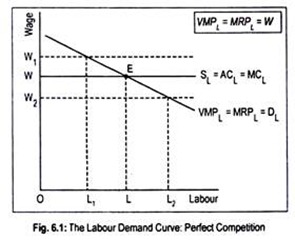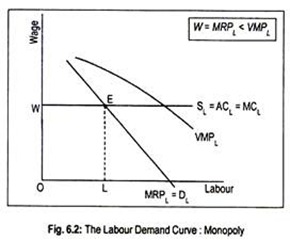This article will guide you about how to derive the demand curve for labour under perfect and imperfect competition.
A Competitive Firm’s Demand Curve for an Input:
A profit-maximizing firm hires variable input till that point at which MC of input equals the VMP or (MRP). Here, by MC of input, we mean price of the input. Since we consider labour as the variable input, its MC is nothing but wage rate. If labour market is characterized by perfect competition, wages will remain fixed.
Since wage rate is fixed, average cost (ACL) and marginal cost (MCL) coincide. At a given wage rate, the supply of labour, SL, (i.e., ACL = MCL) becomes horizontal. Assuming perfect competition in both product market and labour market, a profit-maximizing firm reaches equilibrium when VMP (= MRP) equals the price of labour, i.e., wage rate.
Thus,
ADVERTISEMENTS:
VMPL = MRPL = ACL = MCL = W
In Fig. 6.1, we have drawn a horizontal supply curve of labour (SL = ACL = MCL). We have also drawn VMP, = MRP, curve as the downward sloping curve. Equilibrium occurs at point E, where VMPL = MRPL = W. Corresponding to this equilibrium point, OL amount of labour is demanded.
If the firm decides to employ OL1 units of labour, then VMPL> OW. It would be wise if the firm hires more labour. It will continue to employ labour until wage equals VMPL. Similarly, the firm will not be maximizing profit if it employs OL2 units of labour where wage exceeds VMPL. Therefore, to have more profit, it must reduce employment of labour until OL is reached where W = VMPL.
ADVERTISEMENTS:
Thus, at OW wage rate, OL amount of labour is demanded by the firm. If wage rate is OW1, the firm will hire OL1 units of labour, and it will demand OL2 units of labour if wage rate is reduced to OW2. Thus, VMPL = MRPL curve can be thought of as the demand curve for labour under perfect competition. In Fig. 6.1, VMPL = MRPL = DL curve is drawn as a negatively sloped labour demand curve.
Demand Curve for Labour: Imperfect Competition:
Under imperfect competition, VMP curve is not the demand curve for a variable input. In this branch of market, labour demand is governed by MRP, and not VMP. Let us further assume that labour market is perfectly competitive. Therefore, supply curve, MCL, would be horizontal.
A profit-maximizing non-competitive firm which purchases labour input from the competitive labour market will employ labour up to that point at which MC = W equals MRP i.e., VMPL > MRPL = MCL = W.
At the given wage rate OW, the monopoly firm reaches equilibrium at point E. At this wage rate, the firm hires OL units of labour since W = MRPL. If wage rate is increased, less labour will be demanded. More labour will be demanded if wage rate is lowered down. Thus, under imperfect competition, MRPL = DL curve is the firm’s demand curve for labour (Fig. 6.2).

